Modeling for Single-Photon Avalanche Diodes: State-of-the-Art and Research Challenges
Abstract
1. Introduction
2. SPAD Operational Principles
2.1. Photon Detection Probability (PDP)
2.2. Dark Count Rate (DCR) and Afterpulsing (AP)
2.3. Timing Jitter
2.4. Front-End Circuit for SPADs
2.5. Limitations
3. PDP Models
3.1. Photon Absorption
3.2. Avalanche Triggering Probability
3.2.1. Van Overstraeten–de Man Model
3.2.2. Okuto–Crowell Model
3.2.3. Lackner Model
3.2.4. Bologna Model
3.2.5. Local Model vs. Non-Local Model
3.3. Comparison and Discussion of PDP Models
4. DCR Models
4.1. Thermally Generated Dark Counts
4.2. Tunneling Generated Dark Counts
5. Timing Jitter Models
6. SPAD Circuit Models
6.1. SPAD Pixel Circuit Models
6.2. SPAD Array Circuit Models and Crosstalk
7. Research Challenges
- Confidential technology information from foundries has led to difficulties for researchers in developing more accurate models. To have an accurate estimation of certain key parameters in SPAD models, it is important to know the doping profile of each region, the depth and thickness of each region, the material of dielectric layers and defect information, etc. Researchers can extract these parameters directly or indirectly from experimental measurements, but these may be complicated and time-consuming. For example, it may be possible to guess the doping profile by measuring the breakdown voltage. It is also possible to measure the thicknesses of the metal layers and/or passivation layers above the active region from the cross-sectional images using a scanning electron microscope (SEM), thus improving the accuracy of PDP and DCR models. An example is shown in Figure 12, in which the top passivation layers and eighth metal layer M8 are shown with depth information [120].
- However, for a realistic SPAD fabricated using advanced CMOS technologies, it is challenging to get accurate information on each passivation layer. Figure 13a,b shows an illustration of the cross-sectional and layout view of a SPAD design using the TSMC 65 Standard CMOS technology, which has nine metal layers and many inter-metal dielectric layers. The fifth metal layer M5 in the dotted boxes, is used to shield the SPAD, with an opening window to reduce the reflection of the light above the active region. However, there are still many inter-metal-dielectric (IMD) layers with different thicknesses and properties which deserve more investigation for the future improvement of SPAD models.
- When designing a SPAD based on CMOS technology, there are several steps that can be followed to improve the performance. First, avoid crossing metal layers above the active region, which can reduce the light being absorbed in the active region. Second, design a suitable distance between STIs and the active region, usually longer than one diffusion length. This is because that surface generation at the silicon/oxide interface is found to be a major contributor to high DCR [31,34]. Third, the size of the active region should be carefully chosen based on the specific technology. If the size of the active region is too large, the measurement will become a problem since a very high DCR can easily saturate the testing equipment. If the size is too small, fewer photons will be collected in the active region. In addition, the PDP of the individual SPAD may decrease due to the decreased detection efficiency near the guard ring region [13]. A general SPAD model that can include customized parameters would be very useful to device designers.
- The development of simulation tools will also benefit the SPAD modeling process. Currently, TCAD is commonly used for simulating electric parameters of SPADs, including the electric field distributions, ionization coefficients, and breakdown voltage, but not their noise performance [121]. However, these parameters need to be exported to be further processed by other software, such as MATLAB. When there are many parameters to be investigated, the modeling process will be complicated and time-consuming. The development of software automation can significantly improve modeling efficiency.
- The dimensions of SPAD models can be extended from one dimension to two dimensions and even three dimensions. Due to the shrinking of technologies, SPADs can be fabricated in a much smaller size, which should take the edge effect into consideration. However, most of the current SPAD models are in 1 dimension. Some of the models have been developed in 2 dimensions for a better estimation of PDP and DCR [12,13,14]. In 3-dimension models, the performance can be more accurate since they can model these parameters with different SPAD shapes, such as circular SPADs, rectangular SPADs, and octagonal SPADs.
- SPAD circuit models can only be used to simulate the electrical performance of SPADs in integrated circuits. It would be significant progress if SPAD device models and SPAD circuit models could be combined. In this case, the input can be a light signal in the simulation instead of the electric stimuli used in existing SPAD circuit models. However, this method also requires the development of software to include the function of simulating multi-physics in circuits.
- The accuracy of SPAD models also depends on the density of mesh points in a simulation process. Without correct mesh settings, convergence problems may occur. That is to say, it is challenging to adjust the mesh settings in semiconductor device simulation. When it comes to SPAD simulations, the convergence issue can be more important due to the rapid change of physical parameters during the avalanche process. To achieve good accuracy, many calculation iterations are needed, which can lead to additional computational and time costs of modeling. To overcome this problem, machine learning techniques can be adopted in SPAD modeling processes. With machine learning, the design parameters, such as doping concentration, dimension or size, shape, as well as other parameters, can be investigated to see their influence on the specific performance of SPADs. With more data available from simulations, machine learning models can be more accurate. Therefore, predictions of SPAD performances based on different technologies can be made without the need for an iterative modeling process again.
8. Conclusions
Author Contributions
Funding
Acknowledgments
Conflicts of Interest
References
- Palubiak, D.P.; Deen, M.J. CMOS SPADs: Design Issues and Research Challenges for Detectors, Circuits, and Arrays. IEEE J. Sel. Top. Quantum Electron. 2014, 20, 409–426. [Google Scholar] [CrossRef]
- Cova, S.; Longoni, A.; Andreoni, A.; Cubeddu, R. A Semiconductor Detector for Measuring Ultraweak Fluorescence Decays with 70 ps FWHM Resolution. IEEE J. Quantum Electron. 1983, 19, 630–634. [Google Scholar] [CrossRef]
- Patanwala, S.M.; Gyongy, I.; Mai, H.; Abmann, A.; Dutton, N.A.W.; Rae, B.R.; Henderson, R.K. A High-Throughput Photon Processing Technique for Range Extension of SPAD-Based LiDAR Receivers. IEEE Open. J. Solid-State Circuits Soc. 2021, 2, 12–25. [Google Scholar] [CrossRef]
- Beer, M.; Haase, J.F.; Ruskowski, J.; Kokozinski, R. Background Light Rejection in SPAD-Based LiDAR Sensors by Adaptive Photon Coincidence Detection. Sensors 2018, 18, 4338. [Google Scholar] [CrossRef] [PubMed]
- Hu, J.; Liu, B.; Ma, R.; Liu, M.; Zhu, Z. A 32 × 32-Pixel Flash LiDAR Sensor With Noise Filtering for High-Background Noise Applications. IEEE Trans. Circuits Syst. I Regul. Pap. 2022, 69, 645–656. [Google Scholar] [CrossRef]
- Lindner, S.; Zhang, C.; Antolovic, I.M.; Wolf, M.; Charbon, E. A 252 × 144 SPAD Pixel Flash Lidar with 1728 Dual-Clock 48.8 ps TDCs, Integrated Histogramming and 14.9-to-1 Compression in 180 nm CMOS Technology. In Proceedings of the 2018 IEEE Symposium on VLSI Circuits, Honolulu, HI, USA, 18–22 June 2018; pp. 69–70. [Google Scholar] [CrossRef]
- Padmanabhan, P.; Zhang, C.; Cazzaniga, M.; Efe, B.; Ximenes, A.R.; Lee, M.J.; Charbon, E. 7.4 A 256×128 3D-Stacked (45 nm) SPAD FLASH LiDAR with 7-Level Coincidence Detection and Progressive Gating for 100 m Range and 10 klux Background Light. In Proceedings of the 2021 IEEE International Solid-State Circuits Conference (ISSCC), San Francisco, CA, USA, 13–22 February 2021; Volume 64, pp. 111–113. [Google Scholar] [CrossRef]
- Zhang, C.; Lindner, S.; Antolovic, I.M.; Mata Pavia, J.; Wolf, M.; Charbon, E. A 30-Frames/s, 252 × 144 SPAD Flash LiDAR with 1728 Dual-Clock 48.8-ps TDCs, and Pixel-Wise Integrated Histogramming. IEEE J. Solid-State Circuits 2019, 54, 1137–1151. [Google Scholar] [CrossRef]
- Jiang, W.; Chalich, Y.; Deen, M.J. Sensors for Positron Emission Tomography Applications. Sensors 2019, 19, 5019. [Google Scholar] [CrossRef]
- El-Desouki, M.M.; Palubiak, D.; Deen, M.J.; Fang, Q.; Marinov, O. A Novel, High-Dynamic-Range, High-Speed, and High-Sensitivity CMOS Imager Using Time-Domain Single-Photon Counting and Avalanche Photodiodes. IEEE Sens. J. 2011, 11, 1078–1083. [Google Scholar] [CrossRef]
- McIntyre, R.J. Multiplication Noise in Uniform Avalanche Diodes. IEEE Trans. Electron. Devices 1966, ED-13, 164–168. [Google Scholar] [CrossRef]
- Liu, Y.; Zhao, Y.; Hu, J.; Ma, R.; Li, D.; Wang, X.; Liu, M.; Zhu, Z. Accurate Prediction of Photon-Detection-Probability Based on the 2-D Dead-Space Model for SPADs. IEEE Sens. J. 2022, 23, 1115–1123. [Google Scholar] [CrossRef]
- Liu, C.H.; Hsien, C.A.; Lin, S. Di 2-D Photon-Detection-Probability Simulation and a Novel Guard-Ring Design for Small CMOS Single-Photon Avalanche Diodes. IEEE Trans. Electron. Devices 2022, 69, 2873–2878. [Google Scholar] [CrossRef]
- Knežević, T.; Nanver, L.; Suligoj, T.; Nanver, L.K. 2D Dark-Count-Rate Modeling of PureB Single-Photon Avalanche Diodes in a TCAD Environment. SPIE OPTO 2018, 10526, 266–275. [Google Scholar] [CrossRef]
- Kindt, W.J.; Van Zeijl, H.W. Modelling and Fabrication of Geiger Mode Avalanche Photodiodes. IEEE Trans. Nucl. Sci. 1998, 45, 715–719. [Google Scholar] [CrossRef]
- Gulinatti, A.; Ceccarelli, F.; Ceccarelli, F.; Ghioni, M.; Rech, I. Custom Silicon Technology for SPAD-Arrays with Red-Enhanced Sensitivity and Low Timing Jitter. Opt. Express 2021, 29, 4559–4581. [Google Scholar] [CrossRef] [PubMed]
- Shimada, S.; Otake, Y.; Yoshida, S.; Endo, S.; Nakamura, R.; Tsugawa, H.; Ogita, T.; Ogasahara, T.; Yokochi, K.; Inoue, Y.; et al. A Back Illuminated 6 μm SPAD Pixel Array with High PDE and Timing Jitter Performance. In Proceedings of the 2021 IEEE International Electron Devices Meeting (IEDM), San Francisco, CA, USA, 11–16 December 2021; pp. 20.1.1–20.1.4. [Google Scholar] [CrossRef]
- Niclass, C.; Soga, M. A Miniature Actively Recharged Single-Photon Detector Free of Afterpulsing Effects with 6ns Dead Time in a 0.18 μm CMOS Technology. In Proceedings of the 2010 International Electron Devices Meeting, San Francisco, CA, USA, 6–8 December 2010. [Google Scholar] [CrossRef]
- Xu, Y.; Xiang, P.; Xie, X. Comprehensive Understanding of Dark Count Mechanisms of Single-Photon Avalanche Diodes Fabricated in Deep Sub-Micron CMOS Technologies. Solid. State Electron. 2017, 129, 168–174. [Google Scholar] [CrossRef]
- Kang, Y.; Lu, H.X.; Lo, Y.H.; Bethune, D.S.; Risk, W.P. Dark Count Probability and Quantum Efficiency of Avalanche Photodiodes for Single-Photon Detection. Appl. Phys. Lett. 2003, 83, 2955. [Google Scholar] [CrossRef]
- Behroozpour, B.; Sandborn, P.A.M.; Wu, M.C.; Boser, B.E. Lidar System Architectures and Circuits. IEEE Commun. Mag. 2017, 55, 135–142. [Google Scholar] [CrossRef]
- Li, N.; Ho, C.P.; Xue, J.; Lim, L.W.; Chen, G.; Fu, Y.H.; Lee, L.Y.T. A Progress Review on Solid-State LiDAR and Nanophotonics-Based LiDAR Sensors. Laser Photon Rev. 2022, 16, 2100511. [Google Scholar] [CrossRef]
- Tsikouras, A.; Peronio, P.; Rech, I.; Hirmiz, N.; Deen, M.J.; Fang, Q. Characterization of SPAD Array for Multifocal High-Content Screening Applications. Photonics 2016, 3, 56. [Google Scholar] [CrossRef]
- Alayed, M.; Palubiak, D.P.; Deen, M.J. Characterization of a Time-Resolved Diffuse Optical Spectroscopy Prototype Using Low-Cost, Compact Single Photon Avalanche Detectors for Tissue Optics Applications. Sensors 2018, 18, 3680. [Google Scholar] [CrossRef]
- Cova, S.; Longoni, A.; Andreoni, A. Towards Picosecond Resolution with Single-Photon Avalanche Diodes. Rev. Sci. Instrum. 1998, 52, 408. [Google Scholar] [CrossRef]
- Deen, M.J.; Basu, P.K. Silicon Photonics: Fundamentals and Devices; John Wiley & Sons: Chichester, UK, 2012. [Google Scholar]
- Gulinatti, A.; Rech, I.; Assanelli, M.; Ghioni, M.; Cova, S. A Physically Based Model for Evaluating the Photon Detection Efficiency and the Temporal Response of SPAD Detectors. J. Mod. Opt. 2010, 58, 210–224. [Google Scholar] [CrossRef]
- Jiang, W.; Scott, R.; Deen, M.J. High-Speed Active Quench and Reset Circuit for SPAD in a Standard 65 nm CMOS Technology. IEEE Photonics Technol. Lett. 2021, 33, 1431–1434. [Google Scholar] [CrossRef]
- Jiang, W.; Scott, R.; Jamal Deen, M. Improved Noise Performance of CMOS Poly Gate Single-Photon Avalanche Diodes. IEEE Photonics J. 2022, 14, 1–8. [Google Scholar] [CrossRef]
- Scott, R.; Jiang, W.; Qian, X.; Deen, M.J. A Multi-Time-Gated SPAD Array with Integrated Coarse TDCs. Electronics 2022, 11, 2015. [Google Scholar] [CrossRef]
- Leitner, T.; Feiningstein, A.; Turchetta, R.; Coath, R.; Chick, S.; Visokolov, G.; Savuskan, V.; Javitt, M.; Gal, L.; Brouk, I.; et al. Measurements and Simulations of Low Dark Count Rate Single Photon Avalanche Diode Device in a Low Voltage 180-nm CMOS Image Sensor Technology. IEEE Trans. Electron. Devices 2013, 60, 1982–1988. [Google Scholar] [CrossRef]
- Bronzi, D.; Villa, F.; Bellisai, S.; Markovic, B.; Tisa, S.; Tosi, A.; Zappa, F.; Weyers, S.; Durini, D.; Brockherde, W.; et al. Low-Noise and Large-Area CMOS SPADs with Timing Response Free from Slow Tails. In Proceedings of the 2012 Proceedings of the European Solid-State Device Research Conference (ESSDERC), Bordeaux, France, 17–21 September 2012; pp. 230–233. [Google Scholar] [CrossRef]
- Pancheri, L.; Stoppa, D. Low-Noise Single Photon Avalanche Diodes in 0.15 μm CMOS Technology. In Proceedings of the 2011 Proceedings of the European Solid-State Device Research Conference (ESSDERC), Helsinki, Finland, 12–16 September 2011; pp. 179–182. [Google Scholar] [CrossRef]
- Richardson, J.A.; Webster, E.A.G.; Grant, L.A.; Henderson, R.K. Scaleable Single-Photon Avalanche Diode Structures in Nanometer CMOS Technology. IEEE Trans. Electron. Devices 2011, 58, 2028–2035. [Google Scholar] [CrossRef]
- Scarcella, C.; Tosi, A.; Villa, F.; Tisa, S.; Zappa, F. Low-Noise Low-Jitter 32-Pixels CMOS Single-Photon Avalanche Diodes Array for Single-Photon Counting from 300 nm to 900 nm. Rev. Sci. Instrum. 2013, 84, 123112. [Google Scholar] [CrossRef]
- Field, R.M.; Lary, J.; Cohn, J.; Paninski, L.; Shepard, K.L. A Low-Noise, Single-Photon Avalanche Diode in Standard 0.13 Μm Complementary Metal-Oxide-Semiconductor Process. Appl. Phys. Lett. 2010, 97, 211111. [Google Scholar] [CrossRef]
- SentaurusTM Device User Guide Version R-2020.09; Synopsys Inc.: San Jose, CA, USA, 2020.
- SentaurusTM Structure Editor. User Guide Version R-2020.09; Synopsys Inc.: San Jose, CA, USA, 2020.
- Ceccarelli, F.; Acconcia, G.; Gulinatti, A.; Ghioni, M.; Rech, I. 83-ps Timing Jitter with a Red-Enhanced SPAD and a Fully Integrated Front End Circuit. IEEE Photonics Technol. Lett. 2018, 30, 1727–1730. [Google Scholar] [CrossRef]
- Henderson, R.K.; Webster, E.A.G.; Grant, L.A. A Dual-Junction Single-Photon Avalanche Diode in 130-nm CMOS Technology. IEEE Electron. Device Lett. 2013, 34, 429–431. [Google Scholar] [CrossRef]
- Jiang, W.; Chalich, Y.; Scott, R.; Deen, M.J. Time-Gated and Multi-Junction SPADs in Standard 65 nm CMOS Technology. IEEE Sens. J. 2021, 21, 12092–12103. [Google Scholar] [CrossRef]
- Incoronato, A.; Cusini, I.; Pasquinelli, K.; Zappa, F. Single-Shot Pulsed-LiDAR SPAD Sensor with on-Chip Peak Detection for Background Rejection. IEEE J. Sel. Top. Quantum Electron. 2022, 28, 1–10. [Google Scholar] [CrossRef]
- Hsieh, C.A.; Tsai, C.M.; Tsui, B.Y.; Hsiao, B.J.; Lin, S. Di Photon-Detection-Probability Simulation Method for CMOS Single-Photon Avalanche Diodes. Sensors 2020, 20, 436. [Google Scholar] [CrossRef] [PubMed]
- Zimmermann, H.; Mahmoudi, H.; Poushi, S.S.K.; Steindl, B.; Hofbauer, M. Photon Detection Probability Enhancement Using an Anti-Reflection Coating in CMOS-Based SPADs. Appl. Opt. 2021, 60, 7815–7820. [Google Scholar] [CrossRef]
- Mahmoudi, H.; Poushi, S.S.K.; Steindl, B.; Hofbauer, M.; Zimmermann, H. Optical and Electrical Characterization and Modeling of Photon Detection Probability in CMOS Single-Photon Avalanche Diodes. IEEE Sens. J. 2021, 21, 7572–7580. [Google Scholar] [CrossRef]
- Gulinatti, A.; Rech, I.; Fumagalli, S.; Assanelli, M.; Ghioni, M.; Cova, S.D. Modeling Photon Detection Efficiency and Temporal Response of Single Photon Avalanche Diodes. Photon Count. Appl. Quantum Opt. Quantum Inf. Transf. Process. II 2009, 7355, 161–177. [Google Scholar] [CrossRef]
- Panglosse, A.; Martin-Gonthier, P.; Marcelot, O.; Virmontois, C.; Saint-Pé, O.; Magnan, P. Modeling, Simulation Methods and Characterization of Photon Detection Probability in CMOS-SPAD. Sensors 2021, 21, 5860. [Google Scholar] [CrossRef] [PubMed]
- Fan-Yuan, G.J.; Teng, J.; Wang, S.; Yin, Z.Q.; Chen, W.; He, D.Y.; Guo, G.C.; Han, Z.F. Optimizing Single-Photon Avalanche Photodiodes for Dynamic Quantum Key Distribution Networks. Phys. Rev. Appl. 2020, 13, 054027. [Google Scholar] [CrossRef]
- Johnsson, D.; Pogany, D.; Willemen, J.; Gornik, E.; Stecher, M. Avalanche Breakdown Delay in ESD Protection Diodes. IEEE Trans. Electron. Devices 2010, 57, 2470–2476. [Google Scholar] [CrossRef]
- Bailey, D.L.; Townsend, D.W.; Valk, P.E.; Maisey, M.N. Positron Emission Tomography; Springer: London, UK, 2005; ISBN 1-85233-798-2. [Google Scholar]
- Sun, P.; Charbon, E.; Ishihara, R. A Flexible Ultrathin-Body Single-Photon Avalanche Diode With Dual-Side Illumination. IEEE J. Sel. Top. Quantum Electron. 2014, 20, 276–283. [Google Scholar] [CrossRef]
- Kohneh Poushi, S.S.; Mahmoudi, H.; Steindl, B.; Hofbauer, M.; Zimmermann, H. Comprehensive Modeling of Photon Detection Probability in CMOS-Based SPADs. In Proceedings of the 2020 IEEE SENSORS, Rotterdam, The Netherlands, 25–28 October 2020. [Google Scholar] [CrossRef]
- Van Overstraeten, R.; De Man, H. Measurement of the Ionization Rates in Diffused Silicon P-N Junctions. Solid. State Electron. 1970, 13, 583–608. [Google Scholar] [CrossRef]
- Okuto, Y.; Crowell, C.R. Threshold Energy Effect on Avalanche Breakdown Voltage in Semiconductor Junctions. Solid. State Electron. 1975, 18, 161–168. [Google Scholar] [CrossRef]
- Chynoweth, A.G. Ionization Rates for Electrons and Holes in Silicon. Phys. Rev. 1958, 109, 1537. [Google Scholar] [CrossRef]
- Lackner, T. Avalanche Multiplication in Semiconductors: A Modification of Chynoweth’s Law. Solid. State Electron. 1991, 34, 33–42. [Google Scholar] [CrossRef]
- Vecchi, M.C.; Rudan, M. Modeling Electron and Hole Transport with Full-Band Structure Effects by Means of the Spherical-Harmonics Expansion of the BTE. IEEE Trans. Electron. Devices 1998, 45, 230–238. [Google Scholar] [CrossRef]
- Forrest Ma, C.L.; Deen, M.J.; Tarof, L.E.; Yu, J.C.H. Temperature Dependence of Breakdown Voltages in Separate Absorption, Grading, Charge, and Multiplication InP/InGaAs Avalanche Photodiodes. IEEE Trans. Electron. Devices 1995, 42, 810–818. [Google Scholar] [CrossRef]
- Ma, C.L.F.; Deen, M.J.; Tarof, L.E. Multiplication in Separate Absorption, Grading, Charge, and Multiplication InP-InGaAs Avalanche Photodiodes. IEEE J. Quantum Electron. 1995, 31, 2078–2089. [Google Scholar] [CrossRef]
- Bandyopadhyay, A.; Jamal Deen, M.; Tarof, L.E.; Clark, W. A Simplified Approach to Time-Domain Modeling of Avalanche Photodiodes. IEEE J. Quantum Electron. 1998, 34, 691–699. [Google Scholar] [CrossRef]
- Okuto, Y.; Crowell, C.R. Ionization Coefficients in Semiconductors: A Nonlocalized Property. Phys. Rev. B 1974, 10, 4284. [Google Scholar] [CrossRef]
- Teich, M.C.; Saleh, B.E.A. Effect of Dead Space on Gain and Noise of Double-Carrier-Multiplication Avalanche Photodiodes. IEEE Trans. Electron. Devices 1992, 39, 546–552. [Google Scholar] [CrossRef]
- Ramirez, D.A.; Hayat, M.M.; Huntington, A.S.; Williams, G.M. Non-Local Model for the Spatial Distribution of Impact Ionization Events in Avalanche Photodiodes. IEEE Photonics Technol. Lett. 2014, 26, 25–28. [Google Scholar] [CrossRef]
- Ghosh, R.K.; Mahapatra, S. Monolayer Transition Metal Dichalcogenide Channel-Based Tunnel Transistor. IEEE J. Electron. Devices Soc. 2013, 1, 175–180. [Google Scholar] [CrossRef]
- Massey, D.J.; David, J.P.R.; Tan, C.H.; Ng, B.K.; Rees, G.J.; Robbins, D.J.; Herbert, D.C. Impact Ionization in Submicron Silicon Devices. J. Appl. Phys. 2004, 95, 5931. [Google Scholar] [CrossRef]
- Cheong, J.S.; Hayat, M.M.; Zhou, X.; David, J.P.R. Relating the Experimental Ionization Coefficients in Semiconductors to the Nonlocal Ionization Coefficients. IEEE Trans. Electron. Devices 2015, 62, 1946–1952. [Google Scholar] [CrossRef]
- Xu, Y.; Xiang, P.; Xie, X.; Huang, Y. A New Modeling and Simulation Method for Important Statistical Performance Prediction of Single Photon Avalanche Diode Detectors. Semicond. Sci. Technol. 2016, 31, 065024. [Google Scholar] [CrossRef]
- Mazzillo, M.; Condorelli, G.; Piazza, A.; Sanfilippo, D.; Valvo, G.; Carbone, B.; Fallica, G.; Billotta, S.; Belluso, M.; Bonanno, G.; et al. Single-Photon Avalanche Photodiodes with Integrated Quenching Resistor. Nucl. Instrum. Methods Phys. Res. A 2008, 591, 367–373. [Google Scholar] [CrossRef]
- Bonanno, G.; Finocchiaro, P.; Pappalardo, A.; Billotta, S.; Cosentino, L.; Belluso, M.; Di Mauro, S.; Occhipinti, G. Precision Measurements of Photon Detection Efficiency for SiPM Detectors. Nucl. Instrum. Methods Phys. Res. A 2009, 610, 93–97. [Google Scholar] [CrossRef]
- Richardson, J.A.; Grant, L.A.; Henderson, R.K. Low Dark Count Single-Photon Avalanche Diode Structure Compatible with Standard Nanometer Scale CMOS Technology. IEEE Photonics Technol. Lett. 2009, 21, 1020–1022. [Google Scholar] [CrossRef]
- Niclass, C.; Gersbach, M.; Henderson, R.; Grant, L.; Charbon, E. A Single Photon Avalanche Diode Implemented in 130-nm CMOS Technology. IEEE J. Sel. Top. Quantum Electron. 2007, 13, 863–869. [Google Scholar] [CrossRef]
- Webster, E.A.G.; Grant, L.A.; Henderson, R.K. A High-Performance Single-Photon Avalanche Diode in 130-Nm CMOS Imaging Technology. IEEE Electron. Device Lett. 2012, 33, 1589–1591. [Google Scholar] [CrossRef]
- Webster, E.A.G.; Richardson, J.A.; Grant, L.A.; Renshaw, D.; Henderson, R.K. A Single-Photon Avalanche Diode in 90-nm CMOS Imaging Technology with 44% Photon Detection Efficiency at 690 Nm. IEEE Electron. Device Lett. 2012, 33, 694–696. [Google Scholar] [CrossRef]
- Stoppa, D.; Mosconi, D.; Pancheri, L.; Gonzo, L. Single-Photon Avalanche Diode CMOS Sensor for Time-Resolved Fluorescence Measurements. IEEE Sens. J. 2009, 9, 1084–1090. [Google Scholar] [CrossRef]
- Charbon, E.; Yoon, H.J.; Maruyama, Y. A Geiger Mode APD Fabricated in Standard 65nm CMOS Technology. In Proceedings of the 2013 IEEE International Electron Devices Meeting, Washington, DC, USA, 9–11 December 2013. [Google Scholar] [CrossRef]
- Wolff, M.A.; Beutel, F.; Schütte, J.; Gehring, H.; Häußler, M.; Pernice, W.; Schuck, C. Broadband Waveguide-Integrated Superconducting Single-Photon Detectors with High System Detection Efficiency. Appl. Phys. Lett. 2021, 118, 154004. [Google Scholar] [CrossRef]
- Cohen, M.; Roy, F.; Herault, D.; Cazaux, Y.; Gandolfi, A.; Reynard, J.P.; Cowache, C.; Bruno, E.; Girault, T.; Vaillant, J.; et al. Fully Optimized Cu Based Process with Dedicated Cavity Etch for 1.75 μm and 1.45 μm Pixel Pitch CMOS Image Sensors. In Proceedings of the 2006 International Electron Devices Meeting, San Francisco, CA, USA, 11–13 December 2006. [Google Scholar] [CrossRef]
- Kamrani, E.; Lesage, F.; Sawan, M. Efficient Premature Edge Breakdown Prevention in SiAPD Fabrication Using the Standard CMOS Process. Semicond. Sci. Technol. 2013, 28, 045008. [Google Scholar] [CrossRef]
- Kamrani, E.; Lesage, F.; Sawan, M. Premature Edge Breakdown Prevention Techniques in CMOS APD Fabrication. In Proceedings of the 10th IEEE International NEWCAS Conference, Montreal, QC, Canada, 17–20 June 2012; pp. 345–348. [Google Scholar] [CrossRef]
- Qian, X.; Jiang, W.; Deen, M.J. Enhanced Photon Detection Probability Model for Single-Photon Avalanche Diodes in TCAD with Machine Learning. In Proceedings of the 2022 IEEE International IOT, Electronics and Mechatronics Conference, IEMTRONICS, Toronto, ON, Canada, 1–4 June 2022. [Google Scholar] [CrossRef]
- Veerappan, C.; Charbon, E. A Low Dark Count P-I-N Diode Based SPAD in CMOS Technology. IEEE Trans. Electron. Devices 2016, 63, 65–71. [Google Scholar] [CrossRef]
- Veerappan, C.; Charbon, E. A Substrate Isolated CMOS SPAD Enabling Wide Spectral Response and Low Electrical Crosstalk. IEEE J. Sel. Top. Quantum Electron. 2014, 20, 299–305. [Google Scholar] [CrossRef]
- Faramarzpour, N.; Deen, M.J.; Shirani, S.; Fang, Q. Fully Integrated Single Photon Avalanche Diode Detector in Standard CMOS 0.18-μm Technology. IEEE Trans. Electron. Devices 2008, 55, 760–767. [Google Scholar] [CrossRef]
- Arbat, A.; Comerma, A.; Trenado, J.; Gascon, D.; Vilà, A.; Arbat, A.A.; Garrido, L.; Dieguez, A.; Garrido, L. High Voltage vs. High Integration: A Comparison Between CMOS Technologies for SPAD Cameras. SPIE NanoScience + Eng. 2010, 7780, 349–356. [Google Scholar] [CrossRef]
- Cheng, Z.; Palubiak, D.; Zheng, X.; Deen, M.J.; Peng, H. Impact of Silicide Layer on Single Photon Avalanche Diodes in a 130 nm CMOS Process. J. Phys. D. Appl. Phys. 2016, 49, 345105. [Google Scholar] [CrossRef]
- Hurkx, G.A.M.; De Graaff, H.C.; Kloosterman, W.J.; Knuvers, M.P.G. A New Analytical Diode Model Including Tunneling and Avalanche Breakdown. IEEE Trans. Electron. Devices 1992, 39, 2090–2098. [Google Scholar] [CrossRef]
- Hurkx, G.A.M.; Klaassen, D.B.M.; Knuvers, M.P.G. A New Recombination Model for Device Simulation Including Tunneling. IEEE Trans. Electron. Devices 1992, 39, 331–338. [Google Scholar] [CrossRef]
- Pancheri, L.; Stoppa, D.; Dalla Betta, G.F. Characterization and Modeling of Breakdown Probability in Sub-Micrometer CMOS SPADs. IEEE J. Sel. Top. Quantum Electron. 2014, 20, 328–335. [Google Scholar] [CrossRef]
- Kane, E.O. Theory of Tunneling. J. Appl. Phys. 2004, 32, 83. [Google Scholar] [CrossRef]
- Qi, L.; Mok, K.R.C.; Aminian, M.; Charbon, E.; Nanver, L.K. UV-Sensitive Low Dark-Count PureB Single-Photon Avalanche Diode. IEEE Trans. Electron. Devices 2014, 61, 3768–3774. [Google Scholar] [CrossRef]
- Panglosse, A.; Martin-Gonthier, P.; Marcelot, O.; Virmontois, C.; Saint-Pe, O.; Magnan, P. Dark Count Rate Modeling in Single-Photon Avalanche Diodes. IEEE Trans. Circuits Syst. I Regul. Pap. 2020, 67, 1507–1515. [Google Scholar] [CrossRef]
- Sicre, M.; Agnew, M.; Buj, C.; Coignus, J.; Golanski, D.; Helleboid, R.; Mamdy, B.; Nicholson, I.; Pellegrini, S.; Rideau, D.; et al. Dark Count Rate in Single-Photon Avalanche Diodes: Characterization and Modeling Study. In Proceedings of the ESSDERC 2021—IEEE 51st European Solid-State Device Research Conference (ESSDERC), Grenoble, France, 13–22 September 2021; pp. 143–146. [Google Scholar] [CrossRef]
- Schenk, A. Finite-Temperature Full Random-Phase Approximation Model of Band Gap Narrowing for Silicon Device Simulation. J. Appl. Phys. 1998, 84, 3684. [Google Scholar] [CrossRef]
- Cova, S.; Ghioni, M.; Zappa, F.; Rech, I.; Gulinatti Sergio Cova, A.; Gulinatti, A. A View on Progress of Silicon Single-Photon Avalanche Diodes and Quenching Circuits. Optics East. 2006, 6372, 123–134. [Google Scholar] [CrossRef]
- Spinelli, A.; Lacaita, A.L. Physics and Numerical Simulation of Single Photon Avalanche Diodes. IEEE Trans. Electron. Devices 1997, 44, 1931–1943. [Google Scholar] [CrossRef]
- Saeed, S.; De Jong, E.M.L.D.; Dohnalova, K.; Gregorkiewicz, T. Efficient Optical Extraction of Hot-Carrier Energy. Nat. Commun. 2014, 5, 4665. [Google Scholar] [CrossRef] [PubMed]
- Jiang, W. CMOS Single-Photon Avalanche Diodes Towards Positron Emission Tomography Imaging Applications. Ph.D. Thesis, McMaster University, Hamilton, ON, Canada, 2021. [Google Scholar]
- Demir, A. Phase Noise and Timing Jitter in Oscillators with Colored-Noise Sources. IEEE Trans. Circuits Syst. I: Fundam. Theory Appl. 2002, 49, 1782–1791. [Google Scholar] [CrossRef]
- Hernandez, Q.; Gutierrez, D.; Jarabo, A. A Computational Model of a Single-Photon Avalanche Diode Sensor for Transient Imaging. arXiv 2017, arXiv:1703.02635. [Google Scholar] [CrossRef]
- Pellegrini, S.; Rae, B.; Pingault, A.; Golanski, D.; Jouan, S.; Lapeyre, C.; Mamdy, B. Industrialised SPAD in 40 nm Technology. In Proceedings of the 2017 IEEE International Electron Devices Meeting (IEDM), San Francisco, CA, USA, 2–6 December 2018; pp. 16.5.1–16.5.4. [Google Scholar] [CrossRef]
- Sun, F.; Xu, Y.; Wu, Z.; Zhang, J. A Simple Analytic Modeling Method for SPAD Timing Jitter Prediction. IEEE J. Electron. Devices Soc. 2019, 7, 276–281. [Google Scholar] [CrossRef]
- Acconcia, G.; Labanca, I.; Gulinatti, A.; Ghioni, M.; Rech, I. Fast Fully Integrated Active Quenching Circuit for Single Photon Counting up to 160 Mcounts/s. Adv. Photon Count. Tech. XIII 2019, 10978, 63–69. [Google Scholar] [CrossRef]
- Sachidananda, S.; Gundlapalli, P.; Leong, V.; Krivitsky, L.; Ling Subash Sachidananda, A.; Ling, A. Realizing a Robust, Reconfigurable Active Quenching Design for Multiple Architectures of Single-Photon Avalanche Detectors. SPIE OPTO 2022, 12008, 54–61. [Google Scholar] [CrossRef]
- Giudici, A.; Acconcia, G.; Labanca, I.; Ghioni, M.; Rech, I. 4 ns Dead Time with a Fully Integrated Active Quenching Circuit Driving a Custom Single Photon Avalanche Diode. Rev. Sci. Instrum. 2022, 93, 043103. [Google Scholar] [CrossRef]
- Keshavarzian, P.; Gramuglia, F.; Kizilkan, E.; Bruschini, C.; Tan, S.S.; Keshavarzian, A.P.; Tng, M.; Chong, D.; Quek, E.; Lee, M.-J.; et al. Low-Noise High-Dynamic-Range Single-Photon Avalanche Diodes with Integrated PQAR Circuit in a Standard 55nm BCD Process. SPIE Def. + Commer. Sens. 2022, 12089, 73–82. [Google Scholar] [CrossRef]
- Zheng, L.; Hu, K.; Wu, J.; Sun, W.; Lixia, Z.; Kang, H.; Jin, W.; Weifeng, S. Active Quenching Circuit with Adjustable Reverse Bias Voltage for Single Photon Avalanche Diodes Arrays. APCOM YSAOM 2022, 12166, 830–835. [Google Scholar] [CrossRef]
- Dervic, A.; Poushi, S.K.; Zimmermann, H. Fully-Integrated SPAD Active Quenching/Resetting Circuit in High-Voltage 0.35-μm CMOS for Reaching PDP Saturation at 650 nm. In Proceedings of the 2021 24th International Symposium on Design and Diagnostics of Electronic Circuits & Systems (DDECS), Vienna, Austria, 7–9 April 2021; pp. 1–5. [Google Scholar] [CrossRef]
- Goll, B.; Steindl, B.; Zimmermann, H. Cascoded Active Quencher for SPADs with Bipolar Differential Amplifier in 0.35 μm BiCMOS. IEEE Photonics J. 2022, 14, 1–8. [Google Scholar] [CrossRef]
- Lakeh, M.D.; Kammerer, J.B.; Uhring, W.; Schell, J.B.; Calmon, F. An Ultrafast Active Quenching Circuit for SPAD in CMOS 28nm FDSOI Technology. In Proceedings of the 2020 IEEE Sensors, Rotterdam, The Netherlands, 25–28 October 2020. [Google Scholar] [CrossRef]
- Xu, Y.; Lu, J.; Wu, Z. A Compact High-Speed Active Quenching and Recharging Circuit for SPAD Detectors. IEEE Photonics J. 2020, 12, 1–12. [Google Scholar] [CrossRef]
- Gulinatti, A.; Rech, I.; Maccagnani, P.; Ghioni, M.; Cova, S. Large-Area Avalanche Diodes for Picosecond Time-Correlated Photon Counting. In Proceedings of the ESSDERC 2005: 35th European Solid-State Device Research Conference, Grenoble, France, 16 September 2005; Volume 2005, pp. 355–358. [Google Scholar] [CrossRef]
- Dalla Mora, A.; Tosi, A.; Tisa, S.; Zappa, F. Single-Photon Avalanche Diode Model for Circuit Simulations. IEEE Photonics Technol. Lett. 2007, 19, 1922–1924. [Google Scholar] [CrossRef]
- He, Q.; Xu, Y.; Zhao, F. An Accurate Simulation Model for Single-Photon Avalanche Diodes Including Important Statistical Effects. J. Semicond. 2013, 34, 104007. [Google Scholar] [CrossRef]
- Zappa, F.; Tosi, A.; Dalla Mora, A.; Tisa, S. SPICE Modeling of Single Photon Avalanche Diodes. Sens. Actuators A Phys. 2009, 153, 197–204. [Google Scholar] [CrossRef]
- Cheng, Z.; Zheng, X.; Palubiak, D.; Deen, M.J.; Peng, H. A Comprehensive and Accurate Analytical SPAD Model for Circuit Simulation. IEEE Trans. Electron. Devices 2016, 63, 1940–1948. [Google Scholar] [CrossRef]
- Niclass, C.; Favi, C.; Kluter, T.; Gersbach, M.; Charbon, E. Timing and Probability of Crosstalk in a Dense CMOS SPAD Array in Pulsed TOF Applications. Opt. Express 2018, 26, 20622–20632. [Google Scholar] [CrossRef]
- Wu, D.R.; Tsai, C.M.; Lin, S. Di Time-Correlated Crosstalk Measurements between CMOS Single-Photon Avalanche Diodes. In Proceedings of the 2018 International Conference on Optical MEMS and Nanophotonics (OMN), Lausanne, Switzerland, 29 July–2 August 2018. [Google Scholar] [CrossRef]
- Ingargiola, A.; Segal, M.; Gulinatti, A.; Rech, I.; Labanca, I.; Maccagnani, P.; Ghioni, M.; Weiss, S.; Michalet, X. Optical Crosstalk in SPAD Arrays for High-Throughput Single-Molecule Fluorescence Spectroscopy. Nucl. Instrum. Methods Phys. Res. A 2018, 912, 255–258. [Google Scholar] [CrossRef]
- Calandri, N.; Sanzaro, M.; Motta, L.; Savoia, C.; Tosi, A. Optical Crosstalk in InGaAs/InP SPAD Array: Analysis and Reduction with FIB-Etched Trenches. IEEE Photonics Technol. Lett. 2016, 28, 1767–1770. [Google Scholar] [CrossRef]
- Cheng, Z. CMOS Based Single Photon Avalanche Diode and Time-to-Digital Converter Towards PET Imaging Appilcations. Ph.D. Thesis, McMaster University, Hamilton, ON, Canada, 2016. [Google Scholar]
- Marinov, O.; Deen, M.J.; Jiménez-Tejada, J.A. Low-Frequency Noise in Downscaled Silicon Transistors: Trends, Theory and Practice. Phys. Rep. 2022, 990, 1–179. [Google Scholar] [CrossRef]
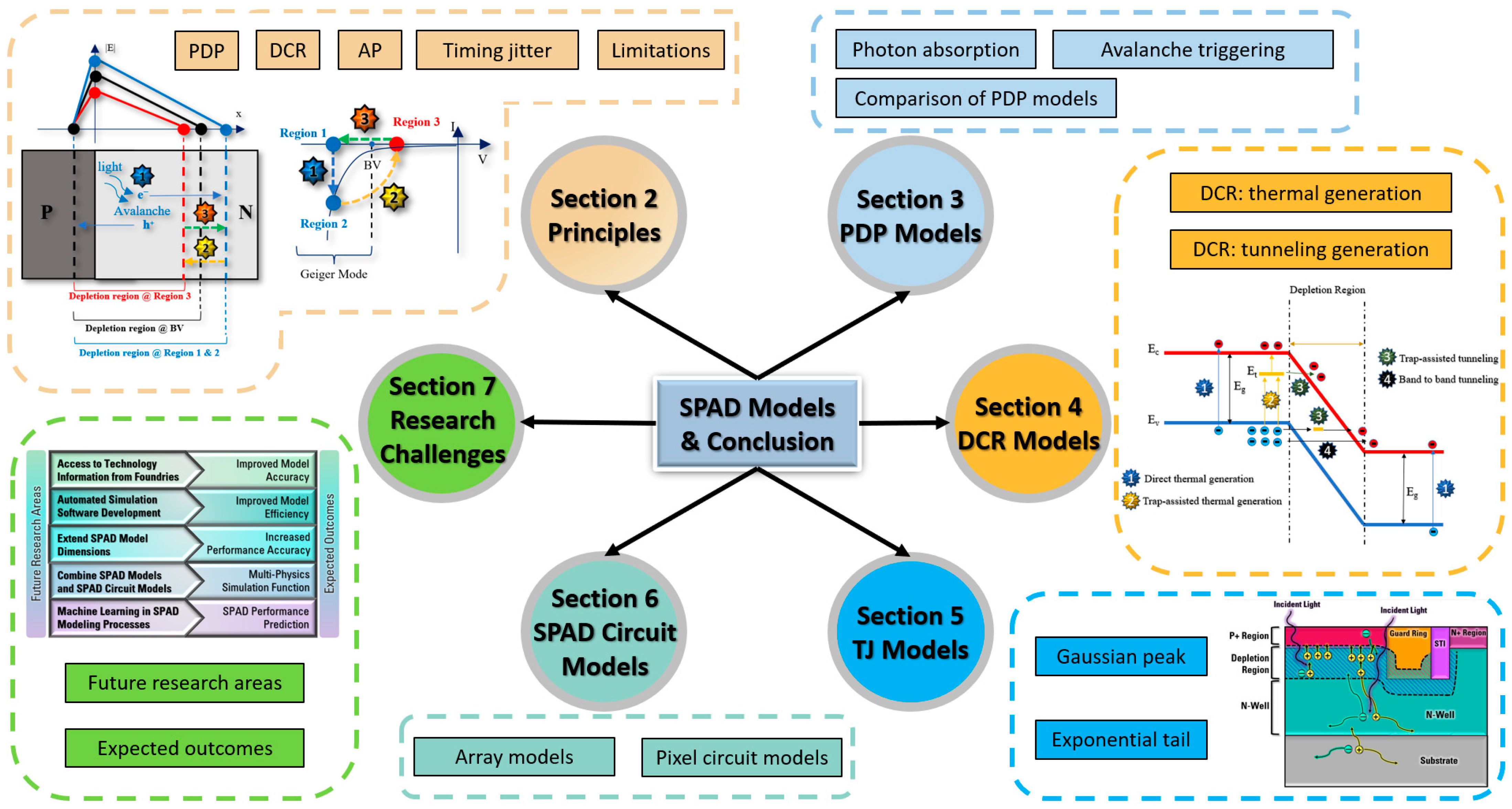

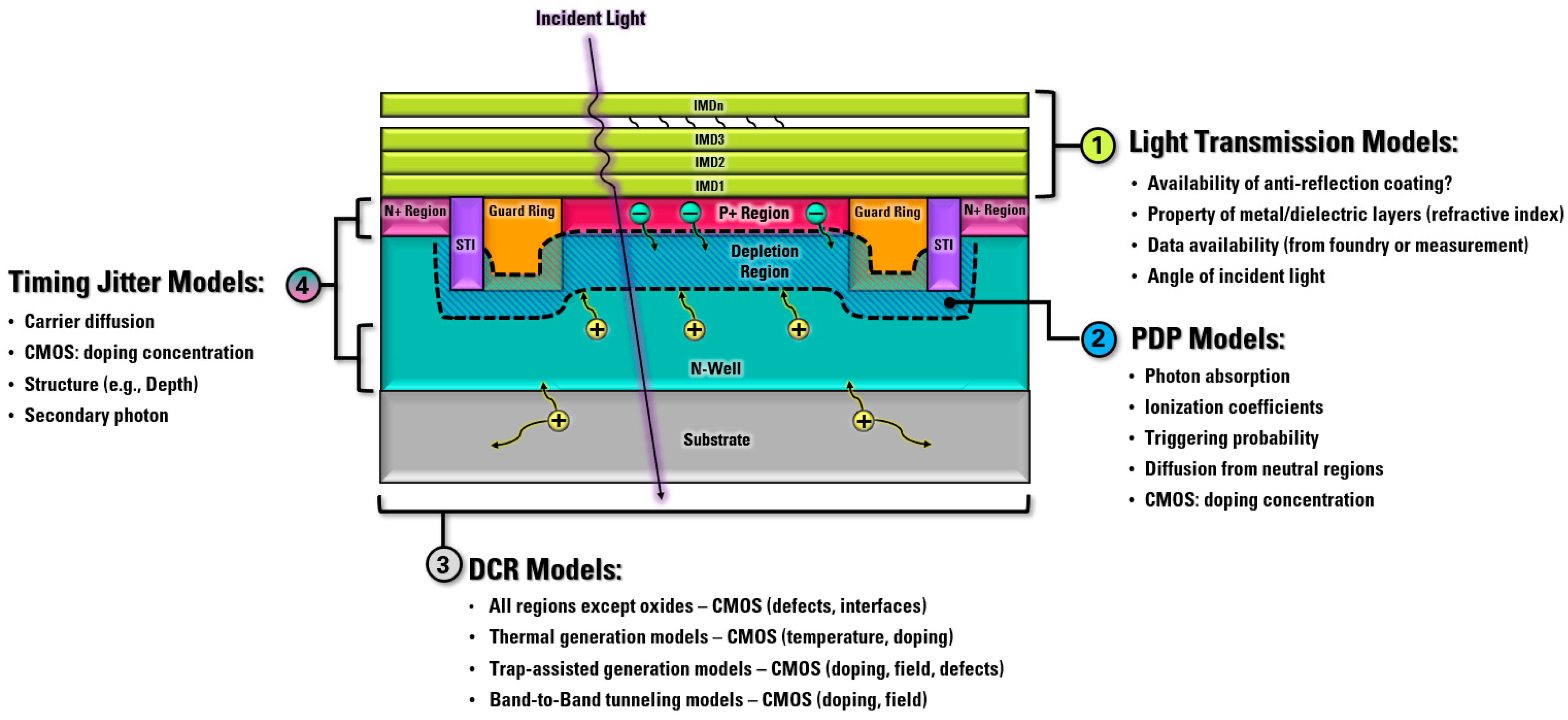
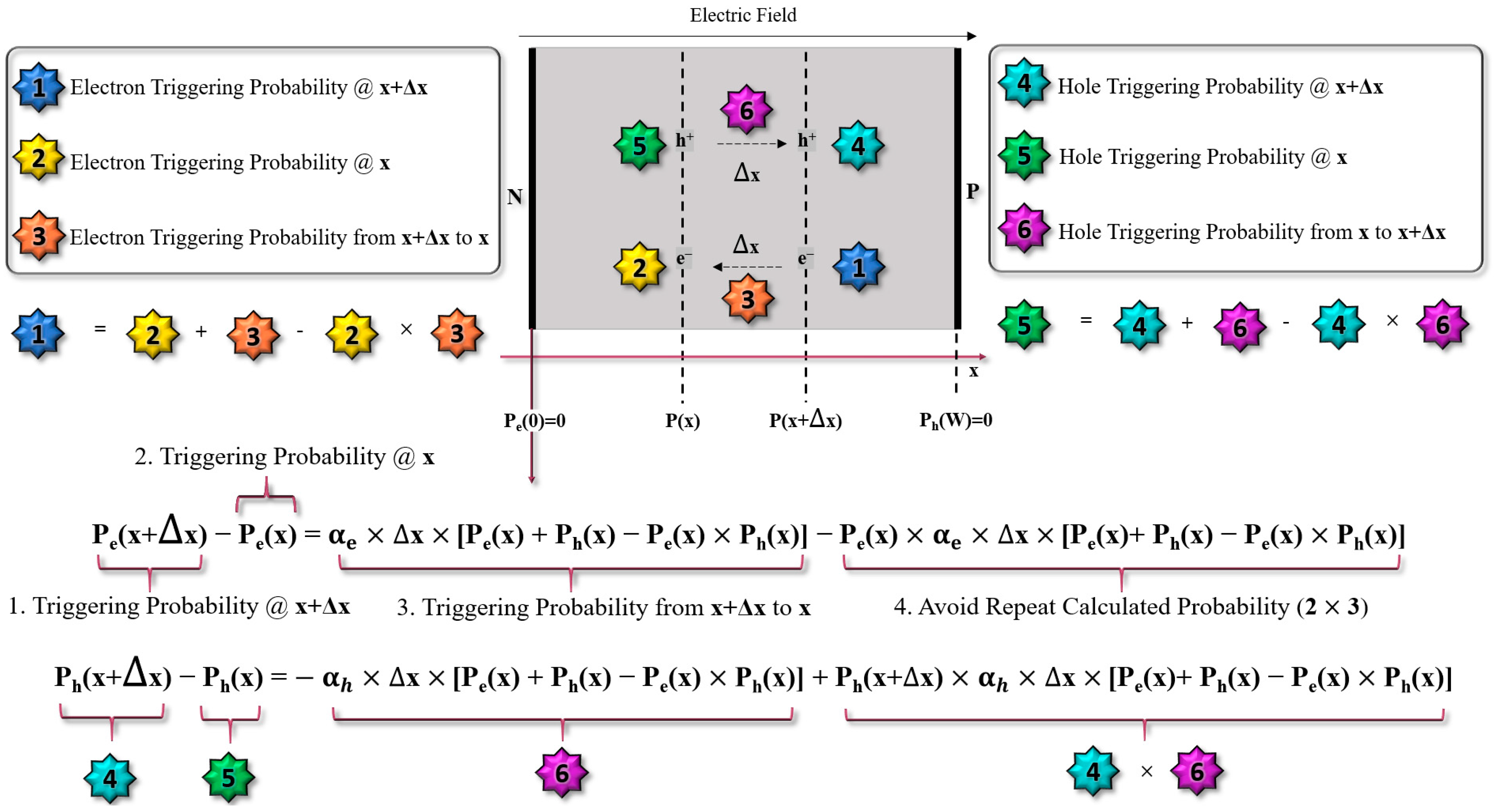
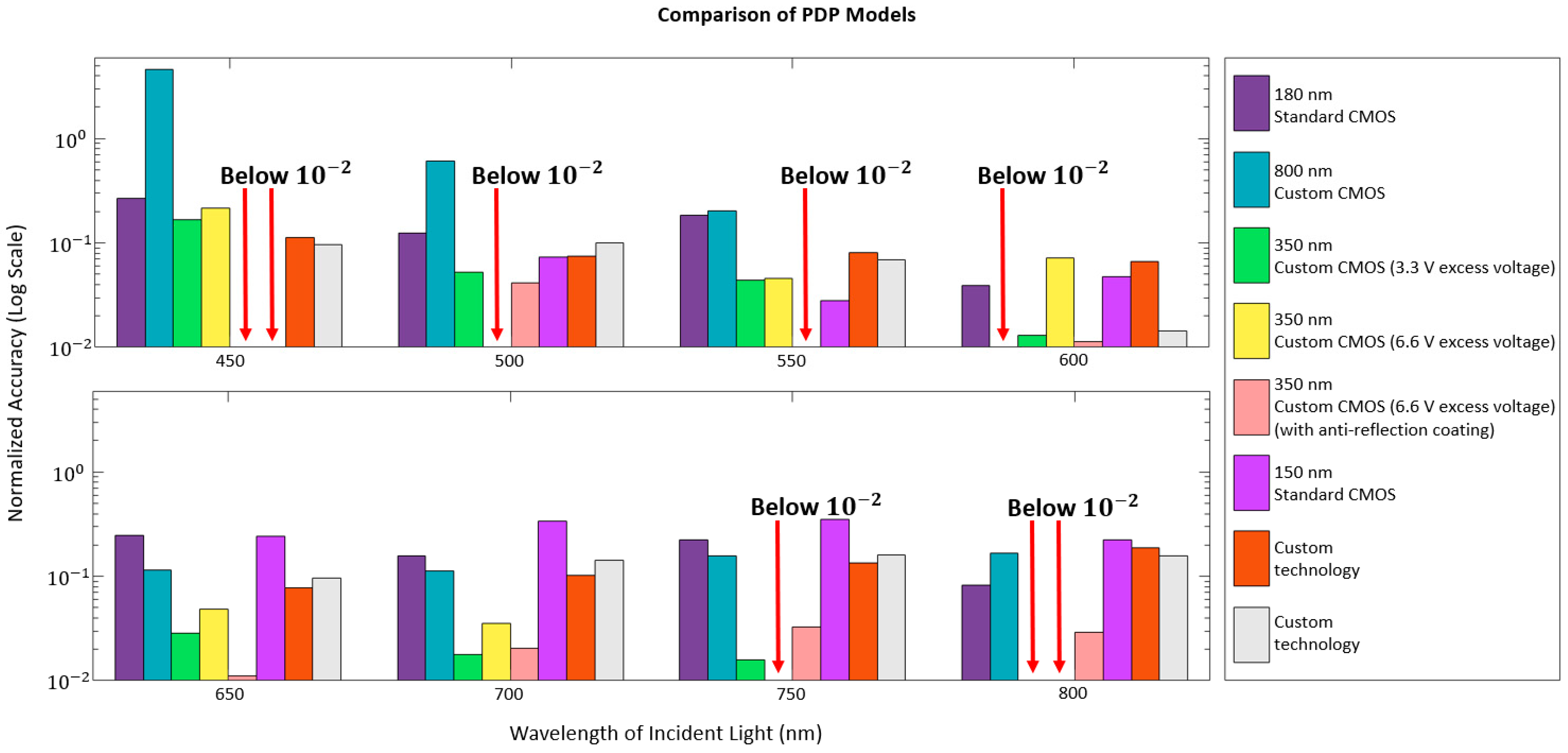






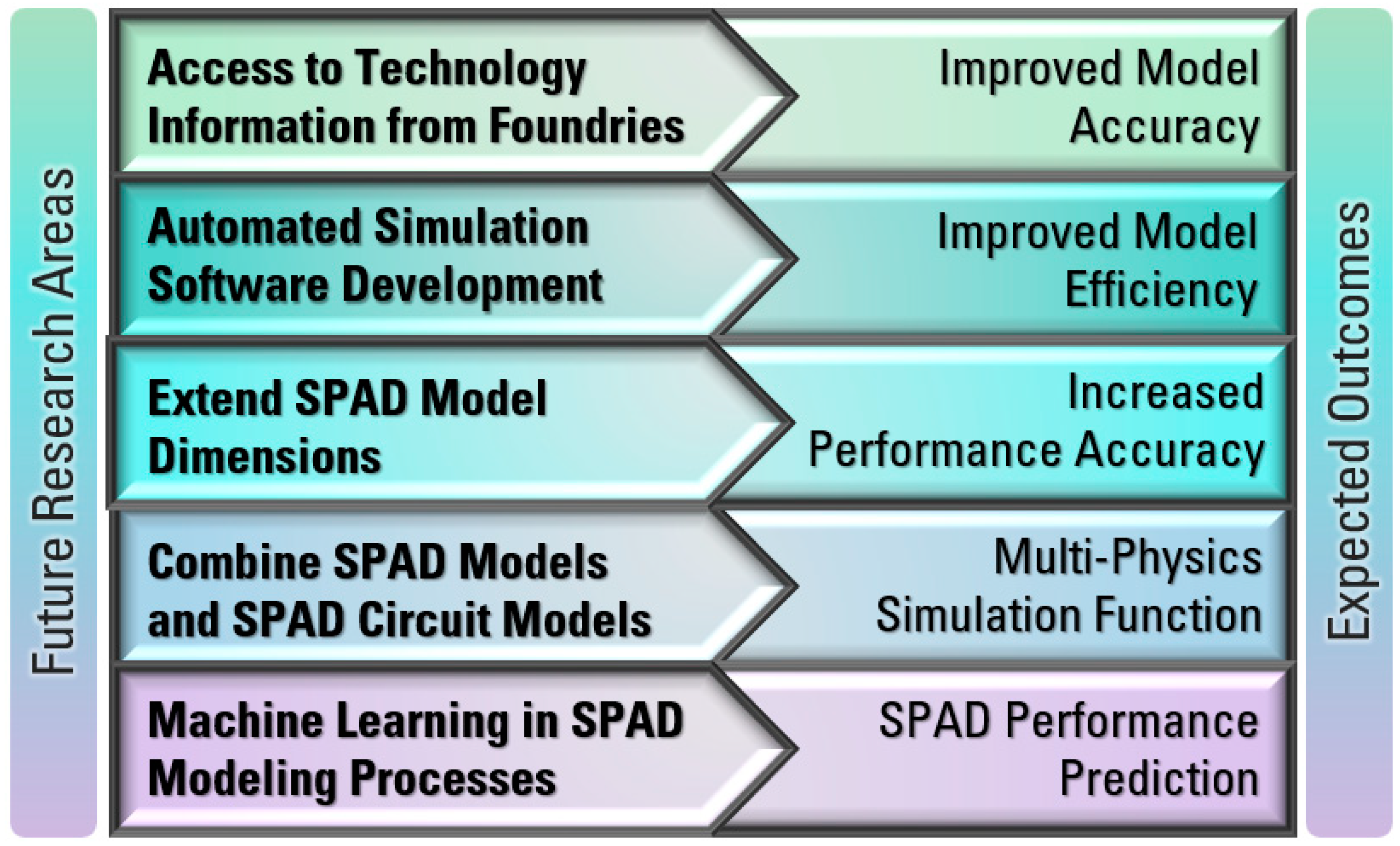

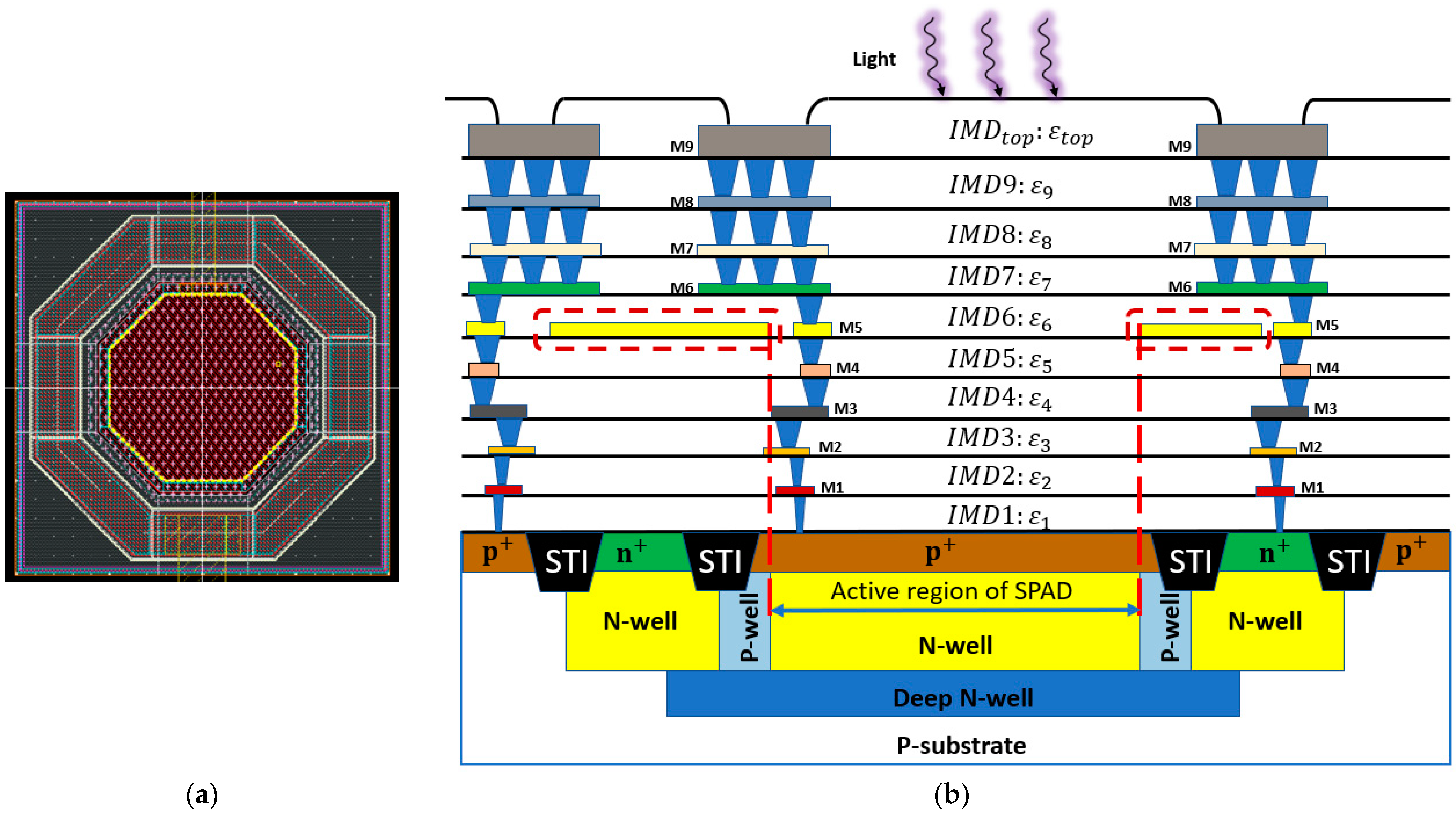
| Model [Ref] | General Form (Electric Field) | Electric Field Range (105 V/cm) | Investigated Parameters | Key Characteristics |
|---|---|---|---|---|
| Van Overstraeten Model [53] | 1.75–6 |
|
| |
| Okuto–Crowell Model [54] | 1–10 |
|
| |
| Lackner Model [56] | 1–10 |
|
| |
| Bologna Model [57] | 0.5–6 |
|
|
| [Ref] Year | Technology Type | Excess Voltage | Incident Light Wavelength Range | Wavelength @ Peak Response * | PDP/PDE Difference ** @ Peak Response | Method | Merits | Key Information | Additional Comments |
|---|---|---|---|---|---|---|---|---|---|
| [47] 2021 | 180 nm Standard CMOS | 15–30% of BV **** | 450 nm–900 nm | ~500 nm | ~12% | TCAD + MATLAB |
|
| Achieved improved accuracy |
| [43] 2020 | 800 nm Custom CMOS | 1 V | 450 nm–900 nm | ~500 nm | ~38% | TCAD + MATLAB |
|
| Fitting parameter free High difference at short wavelengths |
| 3 V | |||||||||
| 5 V | |||||||||
| [45] 2021 | 350 nm High-voltage CMOS | 3.3 V | 450 nm–850 nm | ~600 nm | ~1.3% | CST Microwave Studio + TCAD |
|
| Readout circuits limit the PDP measurement below 2 V excess |
| [44] 2021 | 350 nm High-voltage CMOS - With ARC | 6.6 V | 450 nm–850 nm | ~650 nm | ~1.1% | CST Microwave Studio + TCAD |
|
| PDP vs. ARC thickness PDP vs. incident angle |
| [44] 2021 | 350 nm High-voltage CMOS - Without ARC *** | 6.6 V | 450 nm–850 nm | ~600 nm | ~3.2% | CST Microwave Studio + TCAD |
|
| Without anti-reflection layer |
| [67] 2016 | 150 nm Standard CMOS | 3 V | 350 nm–800 nm | 450 nm | ~0% | TCAD |
| - | Light transmission was not included |
| [27] 2010 | Custom Technology | 5 V | 400 nm–1000 nm | 550 nm | ~68% | TCAD |
|
| Limited information on layers above the active region |
| [46] 2009 | Custom Technology | 3 V | 400 nm–1000 nm | 550 nm | ~61% | TCAD |
|
| Limited information on layers above the active region |
| Ref | SRH * | TAT ** | BTBT *** | Tools/Methods | Comments |
|---|---|---|---|---|---|
| [87] | Yes | Yes | Yes | Analytical |
|
| [86] | Yes | Yes | Yes | Analytical |
|
| [15] | - | Yes | - | Analytical |
|
| [19] | Yes | Yes | Yes | TCAD **** |
|
| [14] | Yes | Yes | Yes | TCAD |
|
| [91] | Yes | - | Yes | TCAD |
|
| [92] | Yes | - | Yes | TCAD |
|
Disclaimer/Publisher’s Note: The statements, opinions and data contained in all publications are solely those of the individual author(s) and contributor(s) and not of MDPI and/or the editor(s). MDPI and/or the editor(s) disclaim responsibility for any injury to people or property resulting from any ideas, methods, instructions or products referred to in the content. |
© 2023 by the authors. Licensee MDPI, Basel, Switzerland. This article is an open access article distributed under the terms and conditions of the Creative Commons Attribution (CC BY) license (https://creativecommons.org/licenses/by/4.0/).
Share and Cite
Qian, X.; Jiang, W.; Elsharabasy, A.; Deen, M.J. Modeling for Single-Photon Avalanche Diodes: State-of-the-Art and Research Challenges. Sensors 2023, 23, 3412. https://doi.org/10.3390/s23073412
Qian X, Jiang W, Elsharabasy A, Deen MJ. Modeling for Single-Photon Avalanche Diodes: State-of-the-Art and Research Challenges. Sensors. 2023; 23(7):3412. https://doi.org/10.3390/s23073412
Chicago/Turabian StyleQian, Xuanyu, Wei Jiang, Ahmed Elsharabasy, and M. Jamal Deen. 2023. "Modeling for Single-Photon Avalanche Diodes: State-of-the-Art and Research Challenges" Sensors 23, no. 7: 3412. https://doi.org/10.3390/s23073412
APA StyleQian, X., Jiang, W., Elsharabasy, A., & Deen, M. J. (2023). Modeling for Single-Photon Avalanche Diodes: State-of-the-Art and Research Challenges. Sensors, 23(7), 3412. https://doi.org/10.3390/s23073412







